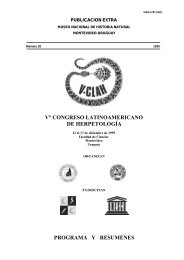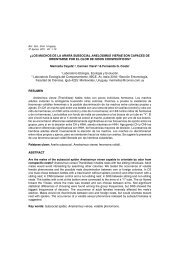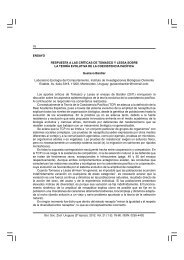Primer Congreso Uruguayo de Zoología - Sociedad Zoológica del ...
Primer Congreso Uruguayo de Zoología - Sociedad Zoológica del ...
Primer Congreso Uruguayo de Zoología - Sociedad Zoológica del ...
You also want an ePaper? Increase the reach of your titles
YUMPU automatically turns print PDFs into web optimized ePapers that Google loves.
ROL DE LOS ANDRÓGENOS COMO MEDIADORES DEL DESARROLLO TESTICULAR EN ELPEJERREY Odontestes bonariensisBlasco, M. 1 ; Somoza, G.M. 1 & Vizziano, D. 21 Laboratorio <strong>de</strong> Ictiofisiología y Acuicultura, IIB-INTECH, Chascomús, Argentina. 2 Laboratorio <strong>de</strong> Fisiología <strong>de</strong> la Reproducción y Ecología<strong>de</strong> Peces, Facultad <strong>de</strong> Ciencias, Uruguay. E-mail: vizziano@gmail.comLa participación <strong>de</strong> los andrógenos en la diferenciación testicular temprana ha sido objeto <strong>de</strong> <strong>de</strong>bate en los peces.Con el objeto <strong>de</strong> estudiar su participación en el pejerrey, en este trabajo se validó en una primera instancia laproducción <strong>de</strong> andrógenos durante el ciclo testicular <strong>de</strong> individuos ya diferenciados, así como en otros órganos <strong>de</strong>lcuerpo (i.e. hígado, riñón anterior, ovario) y luego se iniciaron estudios sobre la producción <strong>de</strong> andrógenos en larvas<strong>de</strong> pejerrey expuestos a temperaturas que inducen la formación <strong>de</strong> machos. Se incubaron testículos, ovarios, hígadoy riñón con 17P-3H, A4-3H, T-3H, y se analizaron los metabolitos por TLC y HPLC. Los resultados mostraron que lostestículos <strong>de</strong> los pejerreyes producían andrógenos 11-oxigenados en forma preferencial (11-KT, 11β-OHA4)observándose que los testículos en inicio <strong>de</strong> espermatogénesis producen mayores cantida<strong>de</strong>s <strong>de</strong> 11-KT con respectoa la 11β-OHA4, que es producida mayormente durante la espermiación. Los ovarios y el hígado no mostraronproducción <strong>de</strong> andrógenos 11-oxigenados, mientras que el riñón es capaz <strong>de</strong> sintetizar la 11β-OHA4. Se extrajerongónadas (junto con peritoneo) <strong>de</strong> larvas en la 5ta semana post-eclosión expuestos a temperaturas formadoras <strong>de</strong>machos (la gónada aún no está diferenciada) y se pudo observar que las gónadas indiferenciadas <strong>de</strong> los futurosmachos eran capaces <strong>de</strong> producir 11-KT. Nuestros resultados sugieren que existe una producción temprana <strong>de</strong>producción <strong>de</strong> 11KT en las gónadas que se están diferenciando hacia machos. Estos resultados junto a los queobtuvimos previamente a partir <strong>de</strong> troncos <strong>de</strong> larvas en don<strong>de</strong> se observó un dimorfismo en la producción <strong>de</strong> 11KTmedida por ELISA, inducen a pensar que los andrógenos 11-oxigenados cumplen un papel temprano comomediadores <strong>de</strong> la diferenciación testicular inducida por temperatura en el pejerrey.A NEW GENUS AND SPECIES OF EUPHRACTINI ARMADILLO (MAMMALIA, CINGULATA)FROM THE LATE OLIGOCENE FRAY BENTOS FORMATION OF URUGUAYBostelmann, E 1 ; Ciancio, M R 2 ; Rin<strong>de</strong>rknecht, A 2 & Perea, D 31 Museo Nacional <strong>de</strong> Historia Natural. Montevi<strong>de</strong>o, Uruguay. 2 CONICET; Departamento <strong>de</strong> Paleontología <strong>de</strong> Vertebrados, Museo <strong>de</strong> LaPlata. La Plata, Argentina. 3 Departamento <strong>de</strong> Evolución <strong>de</strong> Cuencas, Facultad <strong>de</strong> Ciencias, U<strong>de</strong>laR. Montevi<strong>de</strong>o, Uruguay.ebostel@yahoo.comPaleogene Dasypodidae are uncommon outsi<strong>de</strong> Patagonian fossil levels making middle latitu<strong>de</strong> localities of greatinterest for the study of their early diversity. In Uruguay, the first mention of the occurrence of Oligocene dasypodidswas provi<strong>de</strong>d by A. Castellanos without a <strong>de</strong>tailed <strong>de</strong>scription or formal <strong>de</strong>signation of a repository for the collectedmaterials. A reclassification of the fossil cingulates housed in the Museo Municipal “Prof. Lucas Roselli” (MLR) allowsus to recognize a new genus and species of Euphractinae Euphractini. MRL 497, 575, 601 and 773, composes differentsets of isolated osteo<strong>de</strong>rms collected in four localities of Nueva Palmira´s neighborhood at the Colonia Department.MNHN 2190 -two fixed osteo<strong>de</strong>rms incorrectly labeled as Eutatus seguini- are assigned to this new genus too, andFCDPV-687, from the Santa Lucía River, is referred with doubts to it. Typical fixed osteo<strong>de</strong>rms are large (20 – 30 mm),rectangular to prismatic, and thick. The externa l surface is smooth, punctuated, and presents convex figures<strong>de</strong>limited by narrow furrows. The central figure is well <strong>de</strong>fined and does not reach the posterior margin. Its distalportion penetrates between the rami of a U-shaped figure, composing a principal figure that occupies all theposterior half of the osteo<strong>de</strong>rm. Three to four (exceptionally five) well <strong>de</strong>limited antero-lateral trapezoidal peripheralfigures surrounds this principal one. The contact zone between osteo<strong>de</strong>rms is slightly concave and smooth, orcovered by poorly <strong>de</strong>veloped <strong>de</strong>nticular projections. The piliferous system exhibits a unique condition amongeuphractins consisting on two large and circular foramina located in the middle of the posterior bor<strong>de</strong>r, coupled withnumerous small size foramina (probably piliferous) placed all around the lateral and posterior margins of theosteo<strong>de</strong>rms. Preliminary evaluation on the Paleogene fossil Euphractini suggests closer affinities of this Uruguayanform with specimens exhumed from the late Oligocene Salla beds in northern Bolivia.<strong>Primer</strong> <strong>Congreso</strong> <strong>Uruguayo</strong> <strong>de</strong> <strong>Zoología</strong> 73







